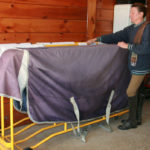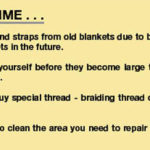Coolers are an indispensable piece of equine clothing. They also take a beating, not just because of their basic job of cooling a horse, but because they are so very good at performing double-duty in your barn.
Cooler function. Horses sweat to eliminate body heat generated by working muscles. Because this heat comes from within, a horse that is working hard will sweat even when the weather is cool. In fact, horses working at high speed in frigid weather can have the sweat freeze right on them.
Sweating continues until the body temperature returns to normal. In warm weather, this isn’t a problem. But when it’s cold, too-rapid cooling can lead to muscle cramping.
Coolers keep the horse warm and wick moisture away from the skin and out to the surface of the blanket. They can help keep the horse’s muscles warm and supple between warm-up and competition time. They’re also great to have on hand for some added warmth on those brisk early mornings at shows.
For warm weather, you want a lightweight cooler that quickly wicks away sweat, dries rapidly and stays in place well, which is exactly what the Wick-Dri Cooler from Weatherbeeta does.
Even if your horse isn’t being worked hard, you may want to have a cooler on hand. Horses soaked by rain can benefit from a cooler to both protect them until they dry and help speed up the process.
In winter, horses can get soaked to the skin and chilled, and a cooler can be just the thing to use till they’re dry and warm. Horses in pain because of colic or an injury may sweat, as can horses with a fever, and can benefit from a cooler.
Fabrics. Not so long ago, all coolers were wool. They were warm and wicked well, but they were heavy. Wool works by being highly absorbent. It pulls in the water from sweat, then starts to release it into the air from its top surface. Wool doesn’t breathe well, which is why it’s an excellent insulator against outside temperatures.
However, it also traps the horse’s body heat, so cooling out in hot weather used to take an hour or longer. We remember the days when trainers insisted on double coolers on all horses, so that the dampness wicked to the top cooler, away from the horse. Some trainers used a layer of straw under the cooler, again to keep the wicked-away moisture off of the horse.
But we think the biggest disadvantage of wool is that it can’t be laundered in water without shrinking. The Schneider’s Contour Wool Blend Cooler performed well, and was warm, but it can’t be washed.
Polar fleece is becoming an increasingly popular fabric for coolers. It’s a synthetic fiber designed to be similar to wool but better. It’s made from a type of polyester, polyethylene terephthalate. It’s washable, breathes well and is much lighter than wool. Polar fleece also doesn’t absorb water well, but it does allow moisture to pass through the fabric easily, making it a good cooler material.
One drawback with fleece that you’ll notice on very dry, cold days is static electricity. This also makes it a magnet for dust and hairs but the pluses far outweigh any negatives. Poor-quality polar fleece can pill, but all coolers in this trial were free of that problem.
Acrylic also has a similar feel to wool and is warm, and the horse dries well underneath, but it doesn’t have a rapid wicking capacity. We found the acrylic Centaur Wickster Sheet has excellent workmanship, styling and attention to detail.
Cotton, like wool, will absorb and hold moisture, releasing it to the air. However, the moisture absorption capacity of cotton is lower than wool. In its favor is a much lighter weight. The only cotton sheet in this trial was the Schneider’s Irish Knit Antisweat Sheet, which contains 80% cotton.
Microfibers are fibers with a small diameter. They are also primarily polyester-based. Because of light weight and rapid wicking, they are often used in athletic clothing. However, they can have more of a heat-trapping effect. The very attractive JPC Equine Couture Monte Carlo Anti-Sweat Sheet is a microfiber weave that we found can easily double as a fly sheet.
Styles. The original cooler design, still available, is simply a large piece of fabric, square to slightly longer than wide. It’s large enough to cover the horse from behind the poll to over the tail and is secured along the neck with heavy blanket clips or clamps. Clamps can also be used along the belly for additional warmth. This no-frills design still gets the job done, but these coolers have a tendency to slip off to one side. Clamps can be rubbed open when horses are pressing on half doors or trailer chest bars and may let go if the horse is free to drop his head to eat. We don’t recommend leaving the horse unattended wearing one of these long, large coolers.
The Brookside Fleece Cooler and the Kensington Polar Fleece Coolers offered ties at the front, but we found these even less secure than clamps. Buckles, T-locks or multiple wide, strong Velcro-type closures are a welcome substitute for blanket clips.
One problem with securing large coolers well is that there is often a lot of extra material at the neck. A welcome modification in some we tested was trimming of this excess to give a more contoured fit.
We especially liked the closure setup on the JPC Equestrian Equine Couture Monte Carlo Anti-Sweat Sheet (see chart). The Rider’s International Fleece Horse Cooler brings the traditional-style cooler to a better fit with a tapered cut, blocking out drafts.
Square styles are best suited for walking your horse or if he’s standing in the stall (not unattended), but still must be well secured with clamps.
The addition of surcingles, hind-leg straps and contoured tailoring to make the coolers fit more like blankets eliminates this slipping problem. Coolers are useful for shipping when your horse hasn’t dried, but use a contour style. They can be used under lighter sheets/blankets for extra insulation in cold weather, making them the most versatile item in your horse’s wardrobe.
Bottom Line. Our top four coolers are the Centaur Wickster, Shires 94X, Schneider’s Ashby and Pessoa coolers with the nod going to the Centaur Wickster Sheet. It’s by far the most versatile in the trial. We like its shoulder liners, closure, surcingle and leg straps capacity and the buckles are stainless steel. It is also the Best Buy in this category.
If you want a more traditional style cooler, we’d go with the Rider’s International Fleece. The contour cut makes for a much better fit and the Velcro closures eliminate the need for a blanket clip. It has excellent workmanship with attention to details like shoulder liners and attractive contrasting binding.
For a hot weather choice, the Weatherbeeta Wick-Dri beats the versatile JPC Couture Monte Carlo sheet. The Wick-Dri is extremely lightweight, well made and dries the horse rapidly.
Horse Journal staff article.







